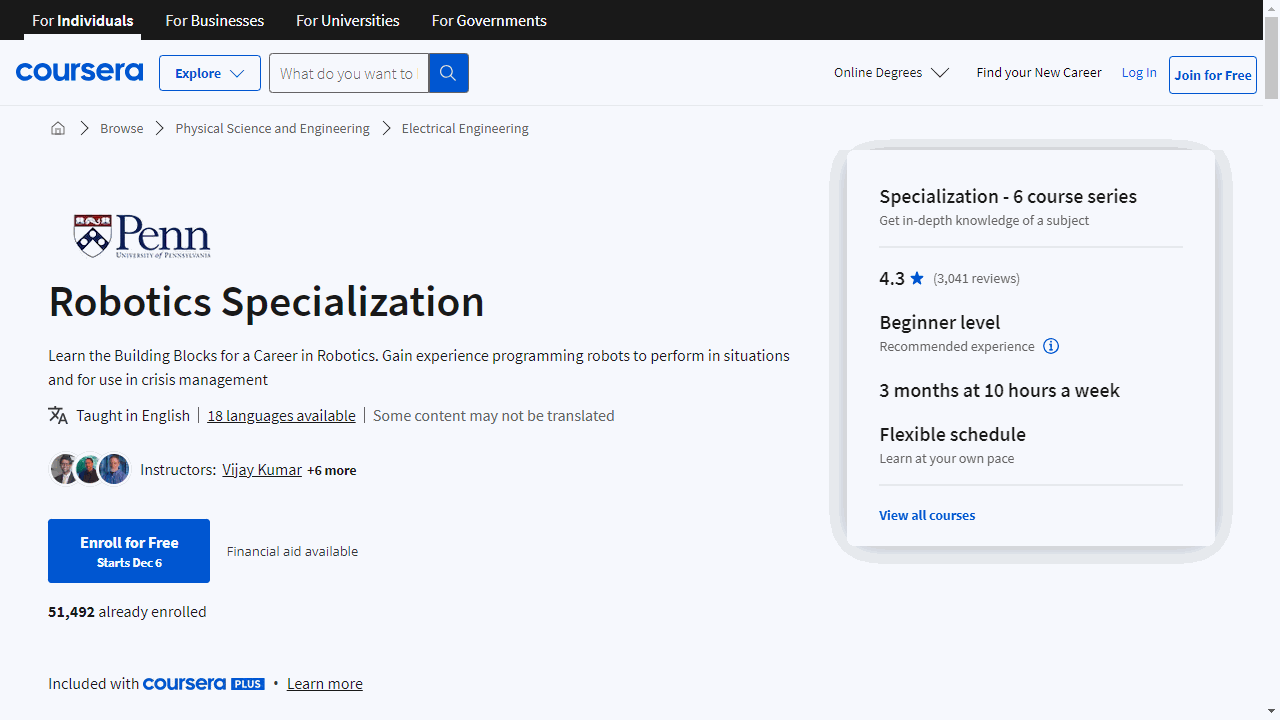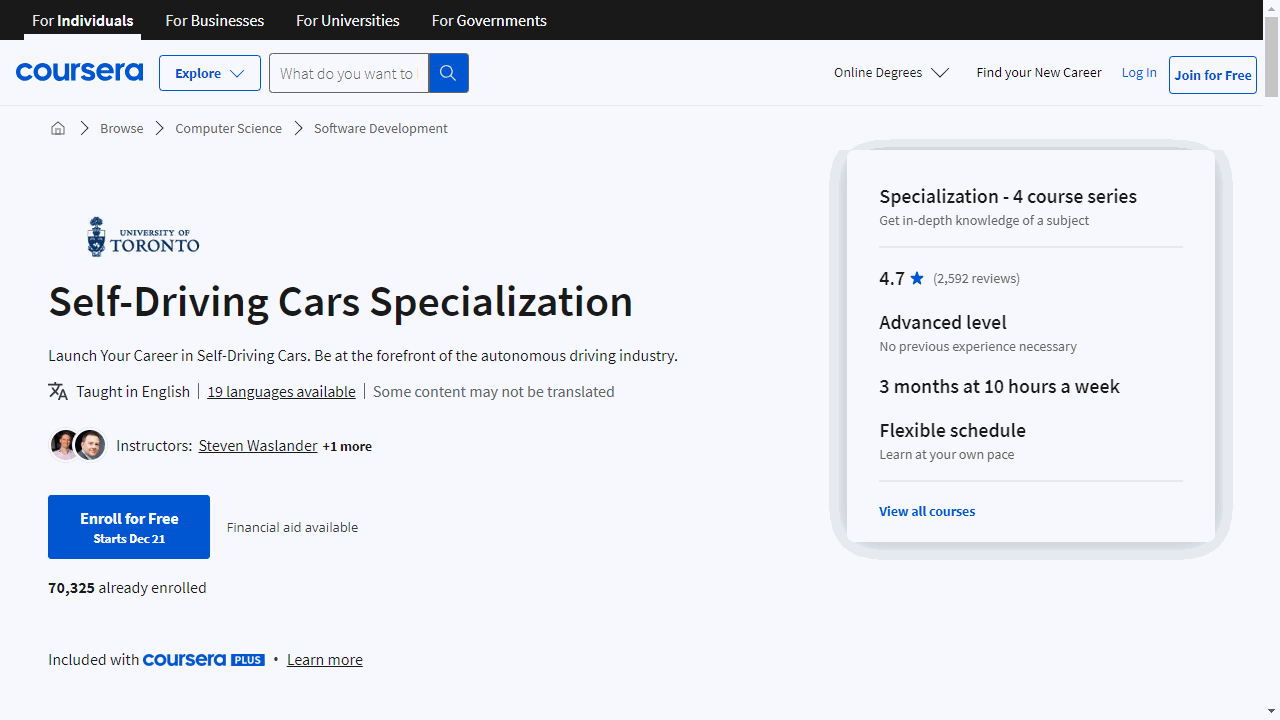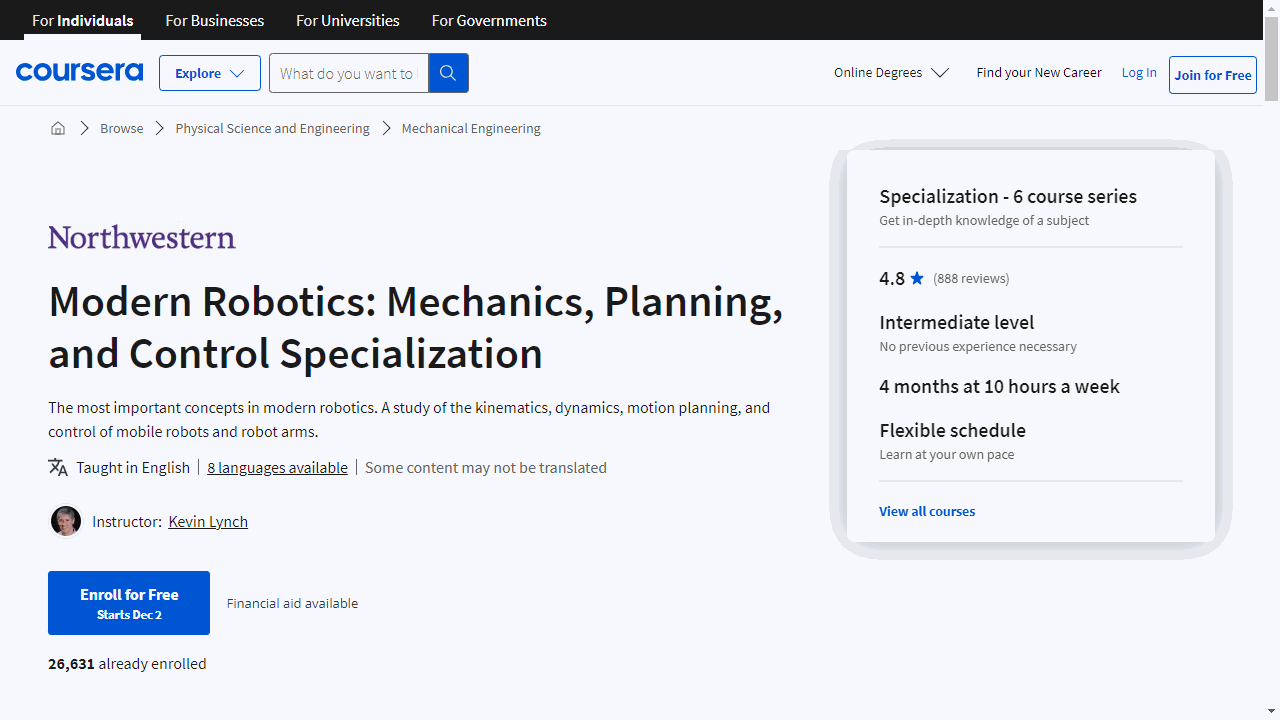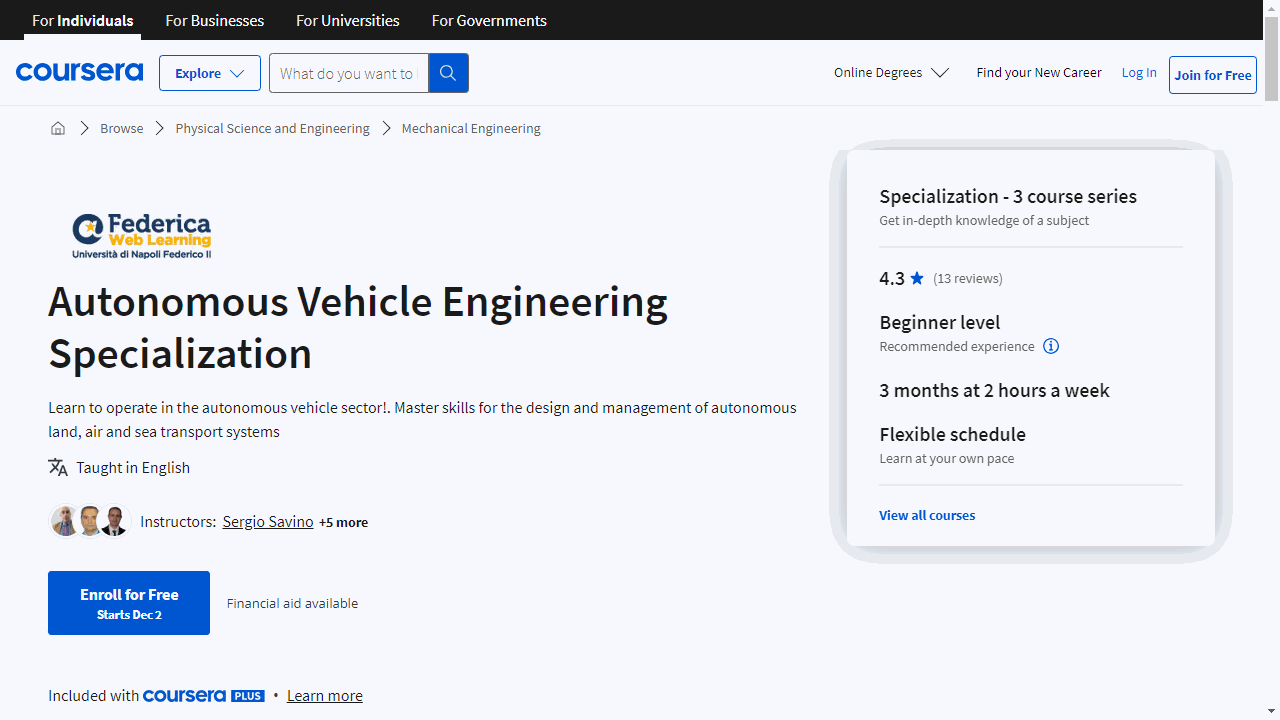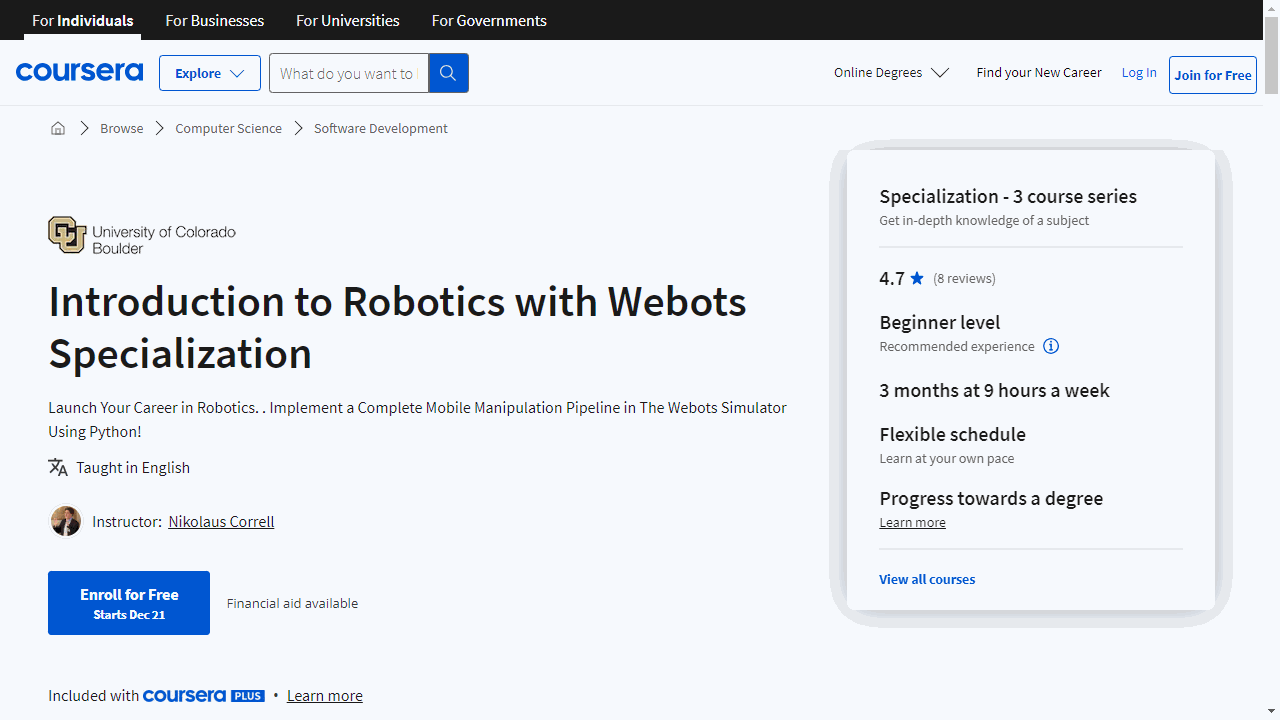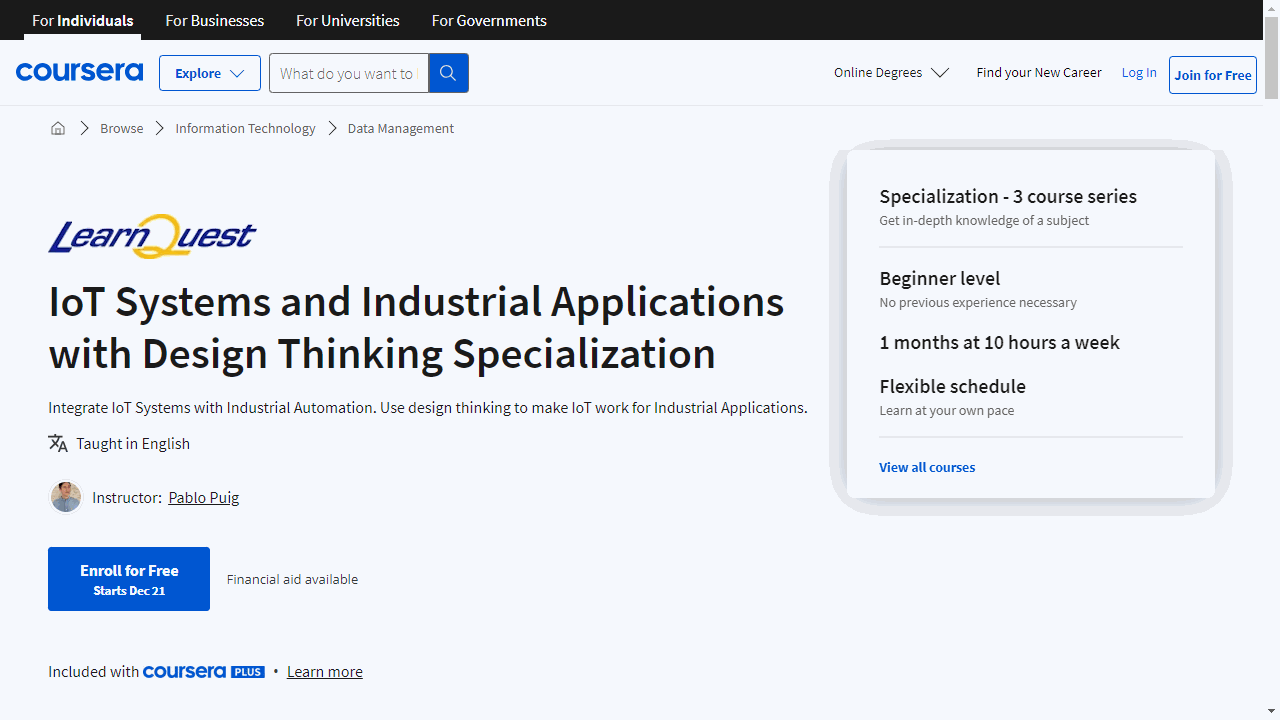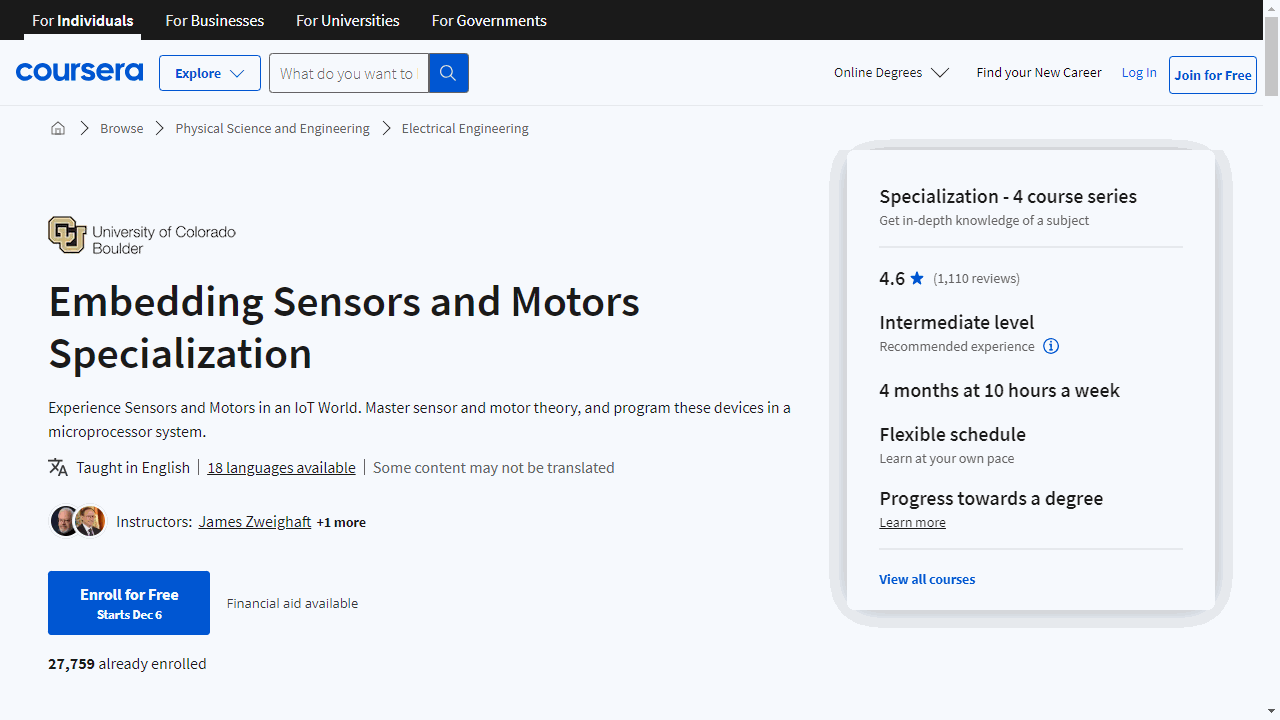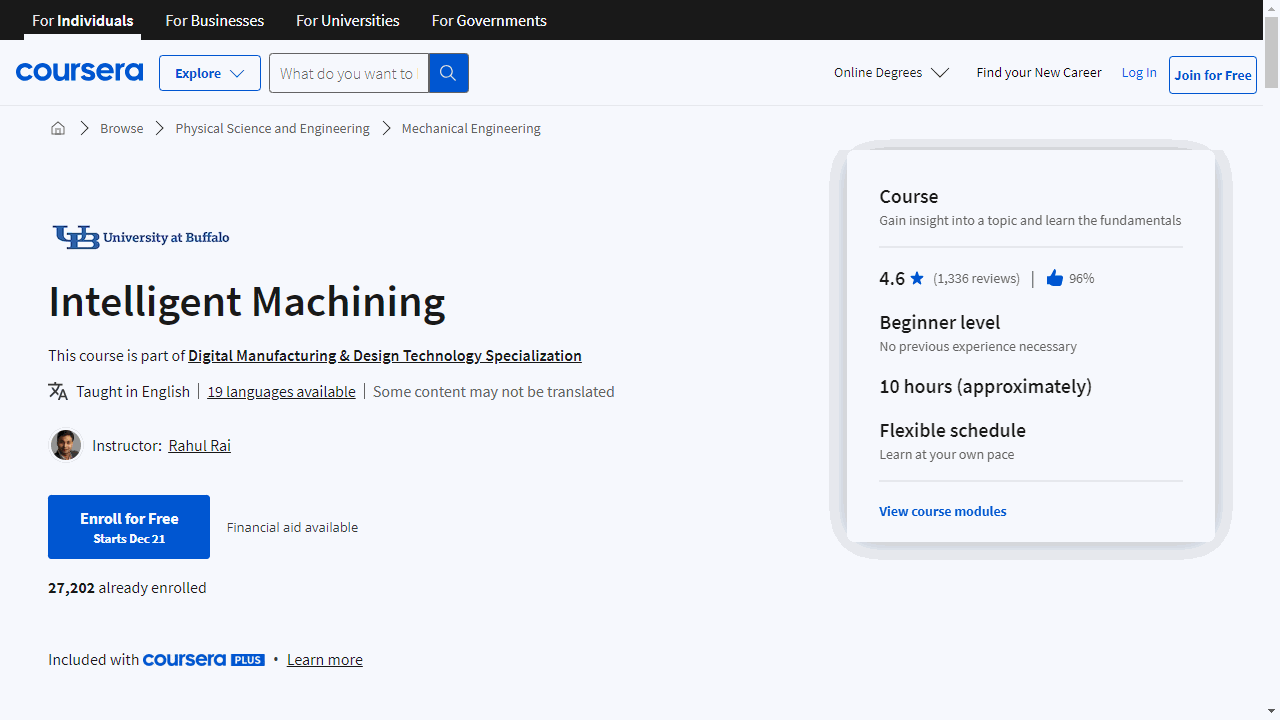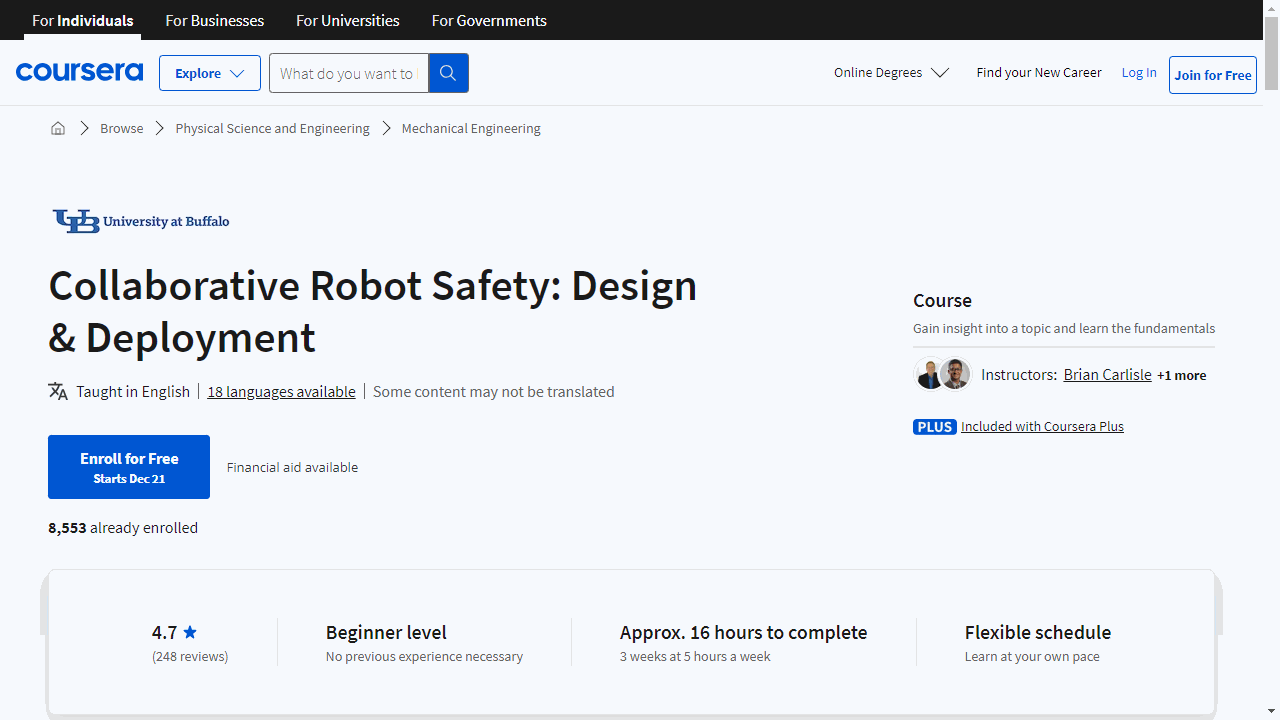Robotics is a fascinating field that blends engineering, computer science, and artificial intelligence to create machines capable of performing complex tasks.
Learning robotics opens doors to exciting career opportunities in fields like automation, manufacturing, healthcare, and more.
Mastering robotics allows you to design, build, and program robots, contributing to innovations that shape our future.
Finding the perfect robotics course on Coursera can feel overwhelming, with so many options available.
You’re looking for a program that’s comprehensive, engaging, and taught by experts, but also fits your learning style and goals.
For the best robotics course overall on Coursera, we recommend the “Robotics Specialization” offered by the University of Pennsylvania.
This program stands out for its comprehensive approach, covering various aspects of robotics, from aerial robotics and motion planning to perception and learning.
The hands-on projects throughout the specialization allow you to apply your theoretical knowledge to real-world scenarios, ensuring you gain practical skills alongside a deep understanding of the subject.
While this is our top pick, there are other excellent robotics courses available on Coursera.
Keep reading to explore our full list of recommendations, tailored to different learning styles and specific areas of robotics, like autonomous vehicles and industrial applications.
Robotics Specialization
Provier: University of Pennsylvania
This series of courses from University of Pennsylvania equips you with practical skills and a deep understanding of robotics.
Start with “Robotics: Aerial Robotics” to delve into quadrotor design and the principles of flight.
You’ll develop dynamic models and controllers, crucial for autonomous drone operation.
A background in linear algebra, calculus, and differential equations, along with MATLAB experience, will help you succeed.
Move on to “Robotics: Computational Motion Planning,” where you’ll tackle the complexities of robotic decision-making.
Learn to navigate obstacles using graph-based methods and randomized planners.
Python programming knowledge will be your tool here.
In “Robotics: Mobility,” discover how robots achieve movement across diverse terrains.
You’ll study the dynamics of legged machines and the creation of sensorimotor programs, enhancing your understanding of robotic locomotion.
“Robotics: Perception” shifts your focus to robotic vision.
You’ll transform camera images into 3D data, enabling robots to navigate and manipulate their environment.
Skills in computer vision and geometry are central to this course.
“Robotics: Estimation and Learning” introduces you to probabilistic models and Bayesian filtering, essential for robots to interpret sensor data and adapt to their surroundings.
Mastery of motion planning and familiarity with MATLAB will be advantageous.
The “Robotics: Capstone” is where you apply your knowledge.
Choose between simulating a mobile inverted pendulum with MATLAB or constructing a rover that navigates autonomously.
This hands-on project demonstrates your ability to translate theoretical knowledge into practical solutions.
Self-Driving Cars Specialization
Provider: University of Toronto
This program is a deep dive into the mechanics and brains of autonomous vehicles, designed for those with a passion for robotics and a solid foundation in engineering or computer science.
Kick off with “Introduction to Self-Driving Cars,” where you’ll unravel the hardware and software essentials of autonomous vehicles.
You’ll get hands-on, programming a simulated self-driving car to navigate a track, honing your Python skills and applying your knowledge of Linear Algebra and Calculus.
Then, “State Estimation and Localization for Self-Driving Cars” sharpens your focus on how these vehicles perceive their position and surroundings.
You’ll master state estimation techniques, including the use of Kalman Filters and LIDAR, culminating in a project that challenges you to localize a car using the CARLA simulator.
“Visual Perception for Self-Driving Cars” immerses you in the car’s sensory world.
Learn to process visual data, enabling the car to detect objects and define drivable areas.
Your project here involves developing algorithms for object detection, using both synthetic and real image data.
Finally, “Motion Planning for Self-Driving Cars” teaches you to chart the car’s course safely and efficiently.
Discover how to navigate around obstacles and comply with traffic laws using algorithms like Dijkstra’s and A*.
Your final project will have you orchestrating a car’s movements through various driving scenarios in the simulator.
Each course is packed with practical skills and projects, ensuring you not only learn but also apply your knowledge.
You’ll need a capable computer to run the CARLA simulator and a background in Python, Linear Algebra, and Calculus to keep pace.
Modern Robotics: Mechanics, Planning, and Control Specialization
Provider: Northwestern University
This specialization is a practical and thorough pathway to mastering the mechanics, planning, and control aspects of robotics.
In “Course 1: Foundations of Robot Motion,” you’ll start by understanding robot configurations and the concept of configuration space (C-space).
You’ll learn about degrees of freedom, holonomic and nonholonomic constraints, and how to express spatial velocities and forces.
Moving on to “Course 2: Robot Kinematics,” you’ll apply your knowledge to solve forward kinematics problems, delve into velocity kinematics, and tackle inverse kinematics.
This course demystifies how a robot’s position and orientation are determined and controlled.
“Course 3: Robot Dynamics” introduces you to forward and inverse dynamics, equipping you with the skills to simulate and control robot movements.
You’ll also learn to plan trajectories that adhere to dynamic constraints.
In “Course 4: Robot Motion Planning and Control,” you’ll navigate the complexities of planning a robot’s path around obstacles and executing real-time motion control.
This course covers essential planning techniques and control strategies.
“Course 5: Robot Manipulation and Wheeled Mobile Robots” explores advanced topics, including robot grasping, manipulation, and the dynamics of wheeled robots.
You’ll gain insights into controlling complex robot systems that combine mobility and manipulation.
The program culminates with “Course 6: Capstone Project, Mobile Manipulation,” where you’ll integrate your skills to control a mobile manipulator.
You’ll program a robot to perform tasks in a simulated environment, using the KUKA youBot as your model.
Throughout the specialization, you’ll develop a robotics software library in Python, Mathematica, or MATLAB and use the free V-REP robot simulator for hands-on practice.
The courses are aligned with the textbook “Modern Robotics: Mechanics, Planning, and Control,” available for purchase or as a free preprint PDF.
Autonomous Vehicle Engineering Specialization
Provider: Università di Napoli Federico II
If you’re eager to master autonomous systems for vehicles, this specialization is a solid choice.
Dive into “A quick tour on Big Data and Business Intelligence” to get a solid foundation in AI and big data concepts.
You’ll learn to manage and extract value from large datasets, and even design AI processes.
Skills like using Apache Hadoop could set you on the path to becoming a Data Scientist or Big Data Architect.
In “Autonomous Aerospace Systems,” you’ll focus on creating sophisticated driving and navigation solutions for autonomous vehicles.
You’ll explore the integration of sensor data for vehicle positioning and movement, honing skills in modeling and simulation that are vital for developing virtual models in mechanical engineering.
“Modelling and simulation of mechanical systems” offers a deep dive into mechatronic systems, where mechanical engineering meets sensors and actuators.
Through case studies in robotics and smart devices, you’ll learn to create mathematical models and develop simulations using Matlab/Simulink.
Each course is designed to equip you with specific, applicable skills in the realm of mechanical engineering, with a special focus on autonomous technologies.
Introduction to Robotics with Webots Specialization
Provider: University of Colorado Boulder
This series of courses builds your skills from the ground up, offering a comprehensive understanding of robotics.
Start with “Basic Robotic Behaviors and Odometry” to get a solid foundation.
You’ll explore the mechanics of autonomous robots, learn about odometry to track their movement, and understand how sensors and actuators work.
Using the Webots simulator, you’ll experiment with real-world scenarios like collision avoidance and line following.
This course is ideal if you’re new to robotics and eager to learn the basics in a hands-on environment.
Move on to “Robotic Mapping and Trajectory Generation” to deepen your knowledge.
Here, you’ll tackle inverse kinematics for precise robot movement and use laser scanners for mapping environments.
This course is crucial for learning how to navigate the uncertainties that sensors and mechanisms can introduce.
The final course, “Robotic Path Planning and Task Execution,” brings everything together.
You’ll develop skills in trajectory planning using algorithms such as Dijkstra’s and A*, and you’ll learn to sequence tasks using Behavior Trees.
Plus, you’ll apply these techniques to a mobile manipulation robot, Tiago Steel, preparing you for real-world robotics applications.
Each course is a stepping stone towards mastering robotics, with the added benefit of earning academic credit towards CU Boulder’s MS in Computer Science.
You’ll gain practical experience in Python programming, algorithm design, and robotic control, all while engaging with the interactive Webots platform.
IoT Systems and Industrial Applications with Design Thinking Specialization
Provider: LearnQuest
This specialization equips you with a robust understanding of IoT’s role in revolutionizing industrial automation and robotics.
Kick off with “Foundations of IoT Systems and Industrial Automation” to build your base.
You’ll explore the evolution and architecture of IoT, delve into sensor technologies, and examine communication protocols.
This course goes beyond theory, showcasing IoT’s practical impact on industries like manufacturing.
You’ll emerge with the know-how to manage data, enhance security, and uphold privacy in IoT systems.
Move on to “Design Thinking for Human-Centered IoT Solutions” to master a user-first approach.
Here, you’ll apply design thinking to craft IoT solutions that truly resonate with users.
Learn to empathize with user needs, ideate solutions, prototype, and test.
This course is ideal if you’re an engineer, developer, or manager looking to create meaningful IoT applications.
Conclude with “Advanced IoT Systems Integration and Industrial Applications” for a deep dive into sophisticated IoT topics.
This course covers edge computing, advanced data analytics, and the fusion of IoT with robotics.
You’ll gain practical skills to address real-world industrial challenges, ensuring IoT systems are secure and effectively integrated with robotics for enhanced automation.
By completing this specialization, you’ll have a comprehensive skill set in systems design, data management, and user-centric design.
Embedding Sensors and Motors Specialization
Provider: University of Colorado Boulder
This specialization offered by University of Colorado Boulder is part of a Master’s degree program.
Starting with “Sensors and Sensor Circuit Design,” you’ll gain the skills to select and implement various sensors into embedded systems.
You’ll learn to manage signal noise and integrate hardware with microprocessors for real-time data processing.
Essential components like the PSOC 5LP PROTOTYPING KIT and an oscilloscope are required, and you’ll find a detailed list of parts in the course content.
Moving on to “Motors and Motor Control Circuits,” you’ll deepen your understanding of motor selection and control.
This course emphasizes the practical application of motor equations and feedback data integration, essential for designing effective motor control circuits.
In “Pressure, Force, Motion, and Humidity Sensors,” you’ll explore a range of sensors and learn to incorporate them into embedded systems.
You’ll build circuits, develop firmware, and process signals for accurate real-time monitoring.
Finally, “Sensor Manufacturing and Process Control” offers insight into the production of sensors and the intricacies of process control.
You’ll learn about sensor calibration, PID control, and manufacturing methods for electro-mechanical and micro-machined sensors.
You’ll need additional equipment like wires, a breadboard, and an oscilloscope, which are vital for the hands-on projects.
Remember to check the required parts list to fully engage with the course projects.
Intelligent Machining
Provider: University at Buffalo
This course gives you a comprehensive understanding of how modern machines operate and adapt, setting you up for success in the rapidly evolving field of robotics.
You’ll begin with the essentials of machining, learning the core principles that govern how machines function.
This foundational knowledge is crucial, as it prepares you for the more advanced topics ahead.
As the course progresses, you’ll delve into the exciting realm of intelligent machining.
Here, you’ll discover the components that empower machines to make decisions and improve over time, such as sensors and signal processing.
These elements are vital, as they enable machines to interpret and respond to their environment.
Machine learning is a key focus of the curriculum.
You’ll gain practical experience in teaching machines to learn from data, a skill that’s increasingly in demand as industries seek to automate and optimize their operations.
The course also covers Programmable Logic Controllers (PLC) and closed-loop process control systems, which are the backbone of machine automation.
Understanding these systems will allow you to ensure that robotic operations are efficient and error-free.
Looking ahead, the course provides insights into the future of intelligent machining.
You’ll have the opportunity to craft your own roadmap for success in digital manufacturing and design technology, giving you a strategic edge in your career.
With a wealth of resources at your disposal, including detailed explanations of machining process control and commonly used software, you’ll finish the course with a deep and practical understanding of intelligent machining.
Introduction to Embedded Machine Learning
Provider: Edge Impulse
This course is a practical gateway into the intersection of robotics and AI, focusing on the application of machine learning to embedded systems.
Starting with the essentials, you’ll grasp the concept of machine learning, its ethical use, and its limitations.
This foundational knowledge is crucial for applying machine learning principles responsibly in robotics.
The course then zooms in on the application of machine learning in embedded devices, a skill set that’s increasingly in demand in the robotics field.
You’ll get hands-on experience with Edge Impulse, a cutting-edge platform for developing machine learning models specifically designed for embedded systems.
You’ll learn how to collect and process motion data, an essential step in teaching robots to interact with their environment.
Feature extraction and selection are covered in detail, empowering you to optimize your machine learning models for efficiency and performance.
As you progress, you’ll delve into neural networks, training models, and the critical evaluation of their performance.
You’ll tackle common challenges like underfitting and overfitting, ensuring your robot’s learning process is on the right track.
Practical exercises include deploying machine learning models to an Arduino and using your smartphone for testing inference, providing you with a comprehensive understanding of the development cycle.
Topics like anomaly detection and sensor fusion are also explored, enhancing a robot’s ability to perceive and interpret its surroundings.
The course culminates with audio classification, where you’ll teach robots to recognize and process sounds using techniques like MFCCs and convolutional neural networks.
This section not only broadens your skill set but also opens up new possibilities for robotic applications.
Throughout the course, you’ll engage in hands-on projects such as motion and sound classification, which not only solidify your learning but also contribute to a portfolio that showcases your expertise.
Support is readily available through troubleshooting guides and a community forum, ensuring you have the resources to overcome any challenges.
Collaborative Robot Safety: Design & Deployment
Provider: University at Buffalo
Starting with robot classification, you’ll learn to identify different robot types and understand their specific safety considerations.
This foundational knowledge is crucial for recognizing how each robot operates and the unique risks involved.
Safety training is a core component of the course, teaching you the essential practices to maintain a secure environment when working with robots.
You’ll become familiar with the critical safety standards that govern robotic applications, ensuring you can uphold and implement these guidelines effectively.
Risk assessment is tackled in depth, empowering you to spot hazards and implement strategies to mitigate them.
This skill is vital for preemptively addressing potential safety issues before they escalate.
The course also delves into designing safe workcells, guiding you through the process of creating spaces where humans and robots can coexist without danger.
You’ll learn about force-limited robots, which are engineered to work closely with humans, minimizing the risk of injury.
Practical applications bring theory to life, with a focus on tasks like machine tending, demonstrating how safety principles are applied in real-world scenarios.
Testing your knowledge through two parts ensures you have a solid grasp of the material.
As you progress, you’ll explore the concept of collaborative workcells, the cutting-edge of human-robot interaction, learning to establish partnerships that are both productive and safe.
Throughout the course, optional resources are available for deeper exploration into each topic.
By the end, you’ll have a comprehensive reference page and key takeaways to reinforce your learning.
Also check our posts on:
